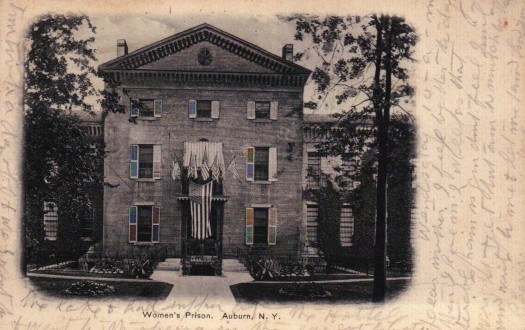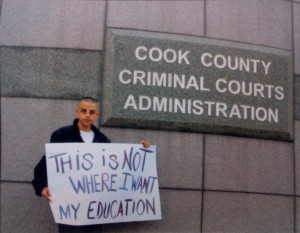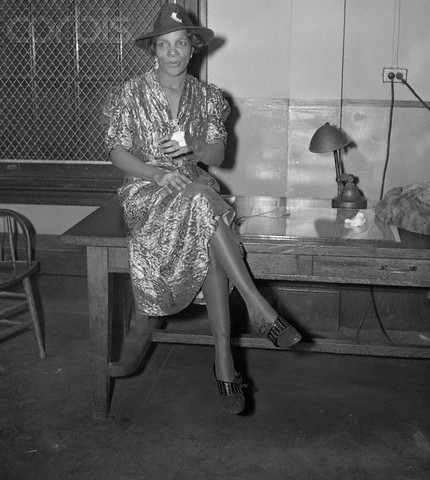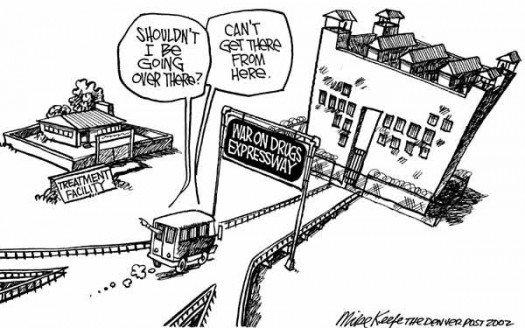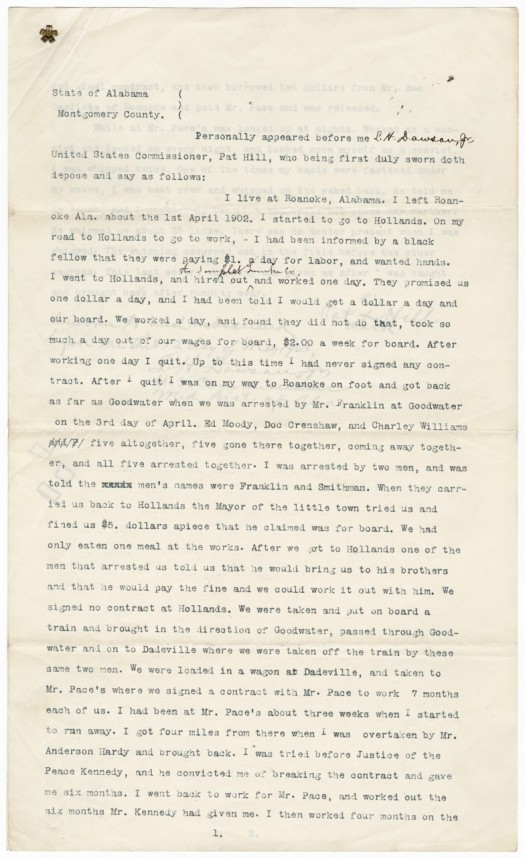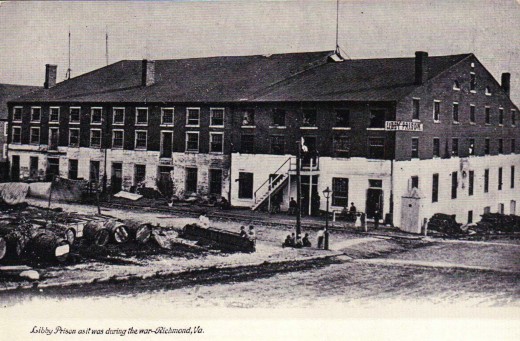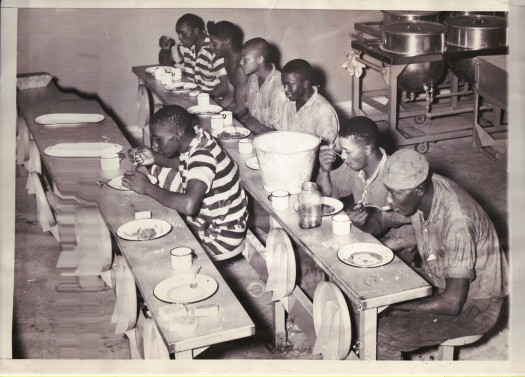Guest Post: A Broken System Perpetuates Itself by Bob Koehler
As some of you know, my organization incubates a terrific program called Circles and Ciphers that is run by two amazing men, Emmanuel Andre and Ethan Ucker. This week a young man who is part of Circles had a hearing. Bob Koehler who volunteers with Circles wrote a wonderful and infuriating essay about Jerry’s case. Please read it and share the story with others. Also, we need to raise $2,000 to bail Jerry out of jail. You can contribute here. [Thanks to everyone’s generosity, we raised enough to cover Jerry’s bond. Jerry was released from jail on Saturday.]
“Wheel about and turn about and do just so. Every time I turn about I jump Jim Crow.” — chorus of an 1828 minstrel song
“We have not ended racial caste in America, we have merely redesigned it.” — Michelle Alexander, The New Jim Crow
Yeah, it’s called mass incarceration. Our jails are filled with black and brown men and women. The number of inmates, primarily people of color, has soared sevenfold in the last three decades, according to Alexander, from 300,000 to more than 2 million, the largest number, by far, in the developed world. Many millions more are on probation or parole. And no matter what their crime, the inmates never get their citizenship back. The stigma of being an ex-felon brands someone for life as a second-class human being.
But even before the ex-felon label is attached, certain people — young men of color, in particular — are targeted as society’s losers by the police, judicial bureaucracy and prison system. They face the possibility of police harassment, invasion of privacy and arrest, often on the smallest pretext possible, pretty much any time they step outside.
I live in a vital, racially and ethnically diverse Chicago neighborhood and I watch it happen — racial profiling, the stop-and-frisk game. This is not making my neighborhood safer. It’s wrecking lives at enormous public expense and, of course, like the insane war on terror, creating enemies. We don’t need a justice system based on stereotypes and armed bullying.
I Wish I Knew More About #3: Madame Stephanie St. Clair
No one has yet written a biography about Madame Stephanie St. Clair and I can hardly believe it. I was introduced to Madame St. Clair through watching the “Cotton Club.” She’s only mentioned in passing. I was born and raised in New York City and even worked for a couple of years in Harlem. Yet I heard nothing about this amazing black woman’s life and legacy. Her Wikipedia page is woefully lacking and describes her as “a female gang leader who ran numerous criminal enterprises in Harlem, New York in the part of the 20th century.” This description of St. Clair doesn’t do justice to her life.
I am very interested in Madame St. Clair because as LaShawn Harris (2008) has written:
“St. Clair’s life symbolizes the often untold narratives and experiences of black men and women who used the informal economy and crime as ways to creatively confront race, gender, and class oppression (p.70).”
Poem of the Day: Tapwater Coffee by Diane Hamill Metzger
Tapwater Coffee
by Diane Hamill Metzger
They took away our coffee pots;
You know the type:
Big forty-cup, with chrome,
Black plastic spigot and feet;
The kind you’d never use at home.
They said a weapon
Potentially lurked there,
Were it heaved or water thrown.
Now in the land of synthetic dreams,
Of cup-a-soup and instant tea,
Another compromise
Slips in to burden me.
I may suck the caffeine
Of paper packets and sleepless nights
And write endless narratives
Of wasted years and trampled rights,
But, try as I may, as I burn midnight oil,
And heat up my verses and curse my toil,
My thirst is room temperature —
My water won’t boil.
Ah, what emotional masturbation
Brews in the grounds of this pleasure dome;
Drinking tapwater coffee.
And thinking of home.Diane Hamill Metzger has been serving a life sentence in Pennsylvania and Delaware state prisons since 1975. She is a widely published creative writer.
The Drug War: Still Racist and Failed #18
The New York Times reports on a new ACLU study about marijuana use and enforcement:
Black Americans were nearly four times as likely as whites to be arrested on charges of marijuana possession in 2010, even though the two groups used the drug at similar rates, according to new federal data.
The Times story includes the following map which illustrates the disparities in marijuana arrests.
Please read the entire interactive ACLU report HERE.
On Black Criminality and Establishing a “Negro Reservation”
I have written very briefly about Khalil Gibran Muhammad’s book “The Condemnation of Blackness: Race, Crime, and the Making of Modern America” here. For those interested in understanding the historical evolution of the idea of ‘black criminality’ in America, I recommend the book. Muhammad suggests that crime statistics were used to reinforce and “condemn” the idea of black criminality especially after the publication of the 1890 census. The idea of ‘black criminality’ was then used to limit black people’s rights and to exclude us from opportunities for social, economic, and political advancement. [As an aside, the most interesting part of the book for me is Muhammad’s contention that black reformers like DuBois and Wells-Barnett inadvertently “contributed to the racialization of crime prevention by linking racial progress to crime fighting” (p. 193). This is a point that I plan to return to in a future post.]
As I’ve been continuing my reading about lynching in the U.S., I came across a book published in 1913 titled “Judge Lynch’s court in America: the number of negro convicts in prison in America” by Rev. Elijah Clarence Branch. Rev. Branch cataloged various injustices against black people and republished several newspaper articles and editorials to document these incidents.
The following editorial caught my attention as it conflates alleged ‘black criminality’ with a need to establish a separate “negro reservation” in the U.S. It’s a wonderful illustration of the way that anti-blackness manifested in the early 20th century and supports claims made by Muhammad. The editorial relies on crime statistics to buttress its exclusionary policy prescription for the “Negro problem.” I think that the echoes of these ideas remain with us today. In some ways, the U.S. has suceeded in creating a “negro reservation;” it’s called the American Prison System.
From the Houston Chronicle, March 3, 1903 (Source: Judge Lynch’s court in America: the number of negro convicts in prison in America p. 24-26 – reproduced as it appears in the book)
Image of the Day: Peonage Case Affidavit
“After the Civil War, a form of slavery continued through a system of peonage, a form of involuntary servitude. Thousands of African Americans were arrested for fabricated crimes and forced to work off exorbitant fines. Pat Hill was a victim of this reenslavement––bound, beaten, and forced to work. The affidavit is his formal sworn statement of fact.”
See the second page of the affidavit here.
Prison Architecture #3
“We Are Not Criminals:” Immigration Reformers in a Box
Over the past few weeks, I’ve been having a Facebook conversation with my friend Rozalinda about the “comprehensive immigration reform (CIR)” bill. It began organically and is informal. It’s intended to be a bit of a stream of consciousness conversation of the sort folks used to have in the French salons of old (but hopefully less pretentious :)).
Rozalinda has archived our conversation here. For those interested in immigration issues and in the carceral state, I invite you to read Rozalinda’s thoughts in particular, she is really brilliant and visionary. Today, I’ve decided to share my latest Facebook note. Both Rozalinda and I invite others to join in the conversation. Feel free to leave comments, ideas, and thoughts at the blog. The more the merrier…
Dear Rozalinda,
It’s taken a few days to respond because as you know I am always swamped with work.
As I’ve been slowly making my way through this “immigration bill,” I have of course noticed that it explicitly excludes people with criminal convictions (of various kinds). Frankly, I understand why it would be framed in this way. I am assuming that the bill’s writers think that this will make it more palatable to certain constituencies. It ensures that only the so-called “deserving” will have access to this potential “gift” of status normalization and citizenship.
The focus on excluding “criminals” has been the part of the bill that has absorbed most of my attention and interest. I want to address myself to some of the points that you raise about immigrant detention and deportations. Writing on the Al-Jazeera blog, Beth Caldwell offers some useful historical context about the uses and purpose of deportation:
“Deportation has a long track record as a tool used to rid societies of people deemed socially undesirable, and excluding those with criminal convictions from immigration reform is consistent with its historic use. Political theorist William Walters traces the origin of modern deportation to political banishment employed by ancient Greece and Rome, the expulsion of poor or religiously unpopular groups during the Middle Ages in Europe, and the forced movement and genocidal practices of Nazi Germany.
Walters argues that during the late 19th century and early 20th century “states increasingly used deportation as a way of governing the welfare of their populations, both by excluding the socially ‘undesirable’ (paupers, prostitutes, anarchists, criminals, the insane, excludable races, etc) and by removing foreign labour… during periods of economic recession”.
The emergence of the term “criminal alien”, designed to both demonise and alienate, exemplifies the relationship between American immigration policy and social cleansing.”
Interestingly within the immigration advocacy community, deportation as a concept is almost never troubled. It is taken as a given that we must deport people. Here’s a quote from a press release announcing a new report that was published by Human Rights Watch:
“The US government is turning migrants into criminals by prosecuting many who could just be deported,” said Grace Meng, US researcher at Human Rights Watch and author of the report. “Many of these migrants aren’t threats to public safety, but people trying to be with their families.”
So advocates are explicitly conceding that some migrants can and should “just be deported” rather than prosecuted for their “crime” of living without documentation in the country. It’s a major concession in my opinion and buys into the framing of the state.
While the current “CIR” bill moves through the Senate, the Department of Homeland Security budget appropriation bill is also being debated on a parallel track. I was particularly interested to read a couple of days ago that Texas Congressman John Culberson “secured language in the [appropriation] bill that requires Immigration and Customs Enforcement (ICE) to use all vacant public and private sector detention facilities to house the detained illegal alien population. ICE will no longer be able to claim it does not have the space to lock up illegal aliens, thereby preventing them from arresting and detaining them.”
So as the Congress works to supposedly “reform” the immigration system on the one hand, on the other it is preparing for the jailing and incarceration of more people. This is something that is basically happening out of the view of most Americans. In addition, the current Senate gang of eight bill includes provisions suggesting that borders must be certified to be “secured” before the “path to citizenship” can officially open for millions of undocumented people. This means that deportations MUST necessarily continue in order for the promised “path to citizenship” to open. What kind of Faustian bargain is this?
While the political rhetoric focuses on deporting “dangerous criminals,” according to ICE’s own statistics in 2012 nearly 35% of the people kicked out of the country had drug or alcohol convictions. The “dangerous criminal” formulation is of course a canard. But it’s an effective one because it is shorthand in this country for those who can be disposed of and those who should be demonized & discounted.
Here’s the problem [as I see it] in addressing this aspect of CIR, we haven’t done a good job opening up the space for discussions about prison abolition in the broader culture. This therefore greatly constrains our ability to have transgressive conversations about ideas such as “criminal aliens” within the context of CIR. Here’s an example of what I mean. While prisons are places where we warehouse people to punish them in this country, they also do the ideological work of isolating and disappearing undesirable populations in the name of “rehabilitating them” and protecting the “good” citizens. This is very important to remember as we talk about immigrants who are always categorized as desirable or not. The rhetoric in the “immigration bill” and more importantly in discussions about the bill suggests that we don’t want to criminalize” and lock up the “good immigrants.” This bill institutionalizes these distinctions and creates new ones. As such, a lot of work has to be done by advocates to prove that immigrants are in fact “good.” It’s a trap and one wonders if advocates are inevitably doomed to fall into it.
The irony of all of this is that the carceral state is deeply invested in circulating “conversion stories” about the “reformed criminal.” Rehabilitation is supposed to be a central tenet of the American prison system. Prisoners themselves often adopt this rhetoric in their writing and in their speeches. They talk about prison being ‘the best thing’ that ever happened to them. They talk about being ‘changed’ or ‘transformed.’ This language and these ideas are embedded and reified within the culture at large. It’s a story that everyone knows. It explains the popularity of films like the Shawshank Redemption.
But interestingly, CIR offers no possibility of a “conversion story” for an immigrant who has been criminalized. That person is automatically disqualified from a quest for citizenship. The immigrant who is criminalized is forever a ‘criminal’ and will be precluded from ever gaining citizenship rights. Why can’t the immigrant be ‘rehabilitated?’ What does this mean about what the country actually believes about the possibilities of so-called ‘rehabilitation’ for ‘criminals?’ How can we use this seeming contradiction as the basis for calling for prison abolition? If the prison is abolished, will we also be rid of the concept of ‘rehabilitation?’ Does this then afford us an opportunity to get outside of the constraints of the concept of “criminality?” These questions are, I think, deserving of more consideration. Without answers though, I think that this leaves immigration reformers in a box that they cannot escape. I want to think more about this box and what it keeps contained when I have a chance…
In the meantime, I’ll give Beth Caldwell [who I cited earlier] the final word:
“The immigration bill currently pending in the US Senate further exacerbates the demonisation of immigrants – primarily Latino and black – who have gotten into trouble with the law. In doing so, the bill falls short of its stated purpose of being “comprehensive” in its effort to reform immigration law. It fails to address some of the most problematic aspects of contemporary American immigration law, including the forced separation of American families.”
From My Collection #20: Georgia Prisoners
More from my collection of prison photographs…
Chow Time
“These convicts were right on time in answering the mess call at the new Georgia prison, in Tattnall County near Reidsville. The prison is expected to sound the death knell of the Georgia chain gangs.”
